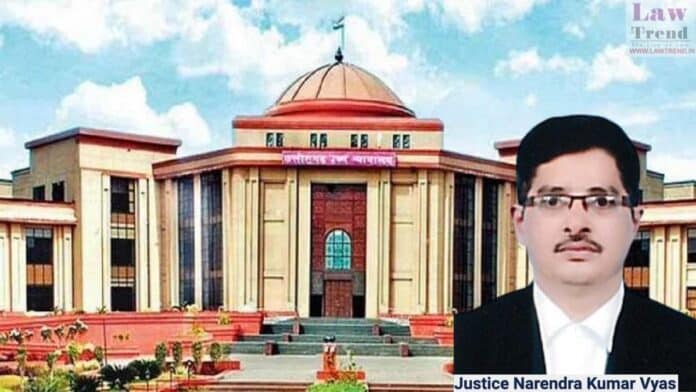The High Court of Chhattisgarh has dismissed a bunch of 1,188 writ petitions filed by teachers (formerly Shiksha Karmis) seeking the benefit of kramonnati (time-bound pay scale) upon completion of 10 years of service.
The Single Bench of Justice Narendra Kumar Vyas, in the case of Smt. Abha Namdeo & Others vs. The State of Chhattisgarh & Others (WPS No. 11009 of 2025 and connected matters), held that Shiksha Karmis appointed under the Panchayat rules were not government servants until their absorption into the School Education Department in 2018. Consequently, they are not entitled to benefits under the circular dated 10.03.2017, which is applicable only to regular government employees.
Background of the Case
The petitioners were initially appointed as Shiksha Karmi Grade-I, II, and III by respective Panchayats under the Madhya Pradesh/Chhattisgarh Panchayat Shiksha Karmi Rules of 1997, 2007, and 2012. They served continuously as Panchayat Karmis or Panchayat Shikshaks until they were absorbed into the School Education Department of the State Government on July 1, 2018, pursuant to a policy decision dated June 30, 2018.
The petitioners approached the High Court claiming benefits of the 1st and 2nd kramonnati (upgradation of pay scale) on completion of 10 years of service, relying on a circular dated March 10, 2017. They heavily relied on a Division Bench judgment of the Chhattisgarh High Court in the case of Smt. Sona Sahu vs. State of Chhattisgarh & others (Writ Appeal No. 261/2023, decided on 28.02.2024), arguing that their cases were squarely covered by this judgment. They contended that denial of the benefit was discriminatory and violative of Articles 14 and 16 of the Constitution of India.
Arguments
Petitioners’ Arguments: The petitioners argued that they had completed 10 years of service and were entitled to kramonnati benefits under the 2017 circular. They contended that the Division Bench in Sona Sahu had allowed similar claims, and the State’s Special Leave Petition (SLP) against that order was dismissed by the Supreme Court. They further cited a Coordinate Bench decision in Ravi Prabha Sahu vs. State of Chhattisgarh (WPS No. 1033/2019), which granted relief based on the Sona Sahu precedent. Counsel for the petitioners argued that if the Single Judge intended to differ from the Coordinate Bench, the matter should be referred to a larger bench.
State’s Arguments: The State, represented by the Additional Advocate General, opposed the petitions. The State argued that Shiksha Karmis were appointed by local bodies (Panchayats) under specific rules and were a separate cadre from regular government teachers. It was contended that the Kramonnati Scheme introduced in 1999 and the subsequent circular of 2017 were applicable only to regular government employees.
The State submitted that the petitioners became government servants only upon absorption on July 1, 2018. The absorption policy explicitly stated that service benefits would accrue from the date of absorption, and past service as Shiksha Karmis could not be counted for government service benefits. Regarding the Sona Sahu case, the State argued that the facts were distinguishable and that the petitioners failed to prove factual parity.
Court’s Analysis and Observations
Justice Vyas examined the legal status of Shiksha Karmis, referring to the Panchayat Raj Adhiniyam, 1993, and relevant recruitment rules. The Court observed that the mode of appointment and service conditions of teachers appointed by Panchayats were distinct from those of the School Education Department.
On Status as Government Servants: The Court cited previous judgments, including Rajiv Kumar Jaiswal vs. State of Chhattisgarh and Arun Singh Bhadouriya vs. State of M.P., to reiterate that Shiksha Karmis are not government servants.
“Merely because he has been placed under the disposal of school owned by the State Government, he cannot claim that he is a government servant… The petitioner cannot be treated as a Government Servant as he is not holder of a civil post under the State but an appointee of a Panchayat which is an independent entity.”
On Applicability of Circular Dated 10.03.2017: The Court noted that the circular dated March 10, 2017, applies to government servants. Since the petitioners were employees of the Panchayat Department until their absorption in 2018, the Court held:
“Since the petitioners who are shikshakarmis are not the Government teachers till their absorption in the School Education Department by the State Government, they cannot claim benefit of the pay parity including kramonnati which has been issued for Teachers working in the School Education Department.”
Distinguishing the Sona Sahu Judgment: The Court meticulously examined the records of the Sona Sahu case. It noted that in Sona Sahu, the appellant had claimed to be an “Assistant Teacher” from the initial appointment, whereas the current petitioners admitted to being appointed as “Shiksha Karmis.”
“The appellant Smt. Sona Sahu has claimed herself to be appointed as Assistant Teacher whereas all the petitioners have clearly pleaded that they are initially appointed as shikshakarmi… Thus, the facts of the case of Smt. Sona Sahu is distinguishable from the present facts of the cases.”
The Court further observed that the petitioners failed to produce documents to establish parity with Sona Sahu despite specific directions from the Court.
On Reference to Larger Bench: Addressing the petitioners’ reliance on the Ravi Prabha Sahu judgment and the request for a larger bench, the Court noted that the State had subsequently issued a clarification regarding the cut-off date for the 2017 circular, fixing it at the date of absorption.
“The cases of the petitioners are different from the judgment passed by the Coordinate Bench in case of Raviprabha Sahu (Supra), as such, the matter is not required to refer to the larger Bench.”
Decision
The High Court concluded that the petitioners are not entitled to the benefits claimed.
“Considering the facts of the case that the petitioners till absorption in pursuance of the policy dated 30.06.2018 are not teachers of the School Education Department, they were shikshakarmis… therefore, the petitioners are not fulfilling the criteria as laid down in the circular dated 10.03.2017, the bunch of the writ petitions are liable to be dismissed.”
Accordingly, all 1,188 writ petitions were dismissed.







